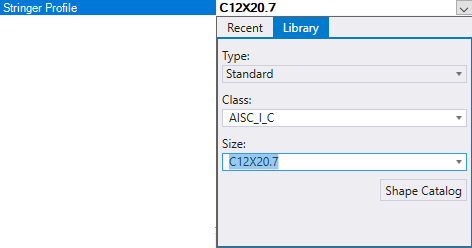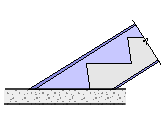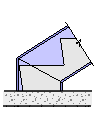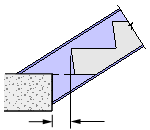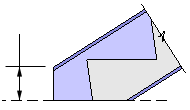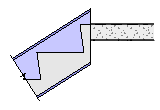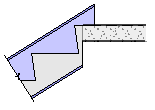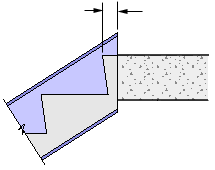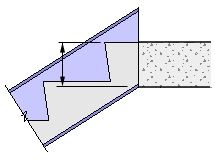Stair Construction Settings - Stringers tab
| Setting | Description | ||||||
|---|---|---|---|---|---|---|---|
| Stringer Base Offset | Sets the distance from the finished floor to the
stinger termination point. It provides a means for either extending or reducing
the length of a stringer. For structural reasons, stringers may extend beyond
the finish floor. Some stringers are encapsulated with concrete at the floor
and the stringer needs to extend down to the floor structure instead of the
floor surface. A positive number is up, a negative number is down.
Finish floor = Base floor point + Base offset Note: Stringers do not follow the
convention of finish floor to finish floor used by tread and riser calculation
using the
Base Offset in the
Placement tab.
|
||||||
| Stringer Top Seat Offset | Sets the distance from the finished floor to the
stinger termination point. To connect to different structural system, the
stringer top offset only applies to the stringer calculation without affecting
the riser/tread calculations. A positive number is up, a negative number is
down.
Tip: The
Top Offset option in the
Placement tab is used
in riser calculations only as a means for either extending or reducing the
length of a stringer.
|
||||||
| Left/Right Stringer Type | Sets the stringer type for the stair. | ||||||
| Stringer Offset | Sets the distance between the nose or foremost edge
of the tread and the top of the stringer, measured perpendicular to the stair
slope.
Note: Disabled when
the Stringer type is set to
Open. For
a
Closed stringer type, depending on the
method used in stringer design, either one or both stringer offset and stringer
carriage offset are necessary. They are interrelated because the depth of
stringer is controlled by our Stringer Section Profile. So if either the Nosing
or Stringer Carriage Offset is set then the other value is the calculated
results of the remaining distance.
|
||||||
| Stringer Profile | Sets the section shape for the stringer elements. The
selection made here overrides the Structural shape defined for the selected
Structural component type. You can select from a list of
Recent section shapes or from the loaded
Library of shapes. You can also browse and
load more shape category types with the available
Shape Catalog option.
Note: If you are
using the
Legacy - Structural Elements, section
definitions are selected using the
legacy section picker.
|
||||||
| Carriage Offset | Sets the distance from the heel of the tread and/or riser to the bottom of the stringer measured perpendicularly to the stair slope. Stringer offset and stringer carriage offset are interrelated. Applicable to open Stringer Types. | ||||||
| Carriage Inset | Sets the value that defines how far the open stringer is inset from the edge of the stair toward the walkline. | ||||||
| Base Profile | Sets the stringer base profile which defines the stringer base end condition and the base connection. | ||||||
| Base Seat Distance | Sets the distance from the first nosing point of the first tread above the finished floor to the vertical cut plane for the stringer seat. Enabled when Top Profile is set to Seat, and applicable for both opened and closed stringer types. | ||||||
| Base Extension Type | Sets the extension type to a
closed stringer type.
|
||||||
| Base Extension Distance | Sets the distance in working units for either the horizontal or vertical extension distance depending on the option selected for the Base Extension Type property. | ||||||
| Top Profile | Defines the stringer top end condition and/or top connection. | ||||||
| Top Seat Distance | Sets the distance from the last nosing point of the last tread below the finish floor to the cut plane for the stringer seat. | ||||||
| Top Extension Type | Sets the extension type to a
closed stringer type.
|
||||||
| Top Extension Distance | Sets the distance in working units for either the horizontal or vertical extension distance depending on the option selected for the Stringer Top Extension Type property. | ||||||
| Top Trim Distance | Sets the perpendicular distance from the finished floor to trim the top of the stringer. | ||||||
| Stringer Part Definition | Sets the stringer family and part pair. Family and Part assignments can be applied straight/slanted panels as well as for planar and parametric profile risers. The selected Part option overrides the native definitions of family part, if any in the profile. |






